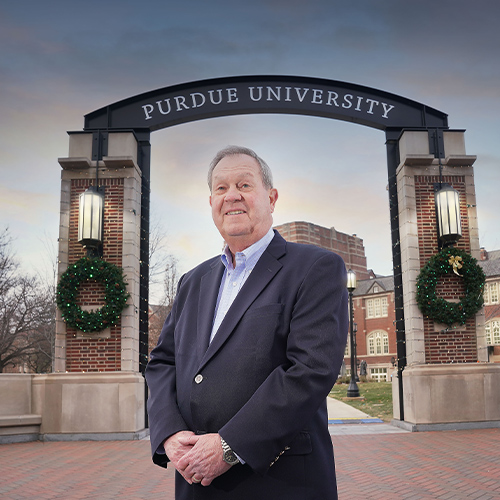Alumni: Stephanie Miller
Degree: BS Forestry
Graduation: 1992
Business Title: Urban Forester
Business: Ohio Department of Natural Resources
I graduated from Purdue in 1992 with a B.S. in Forestry (Urban Option) and am currently the one of six Regional Urban Foresters for the Ohio Department of Natural Resources, Division of Forestry. Our Urban Foresters provide direct management assistance to Ohio’s communities and I cover a 19 county area in the northwest corner of the state. My clientele includes volunteer tree commissioners, mayors, urban foresters, community administrators/managers/staff, and other government agencies. It is a constant learning experience keeping up with the newest technologies, plant health issues, and personalities. Working directly with communities offers Ohio’s urban forestry program a unique opportunity to identify practical solutions that best fit each community’s needs.
Several events highlight my career. Some have been challenging. Most have been rewarding. Working on the front lines of Emerald Ash Borer (EAB) and Gypsy Moth were two of the biggest opportunities since Dutch Elm Disease to bring urban forestry to the public’s attention. Encouraging electric utilities to adopt modern line clearance pruning standards always offers a platform to discuss proper pruning with a variety of audiences. After nearly 20 years, we are still challenged with addressing a problem of deeply planted tree stock. Of course climate change is looming, and a greater capacity for scientific study has allowed me to fine-tune my tree risk assessment skills and support tree biomechanics research (even if it’s just being the cook.) Of course the computer age has changed so much of what we do. E-mail and cell phones have heightened the public’s expectations while making us accessible 24 hours a day. I had to learn how to turn it off and make a clear separation between my work life and home. It is just too stressful and unhealthy otherwise.
In the midst of Ohio’s EAB infestation, our program celebrated its official 25th anniversary while realizing that many of our trained tree commissioners and community leaders were aged and retiring. It was a mass exodus of knowledge that we had developed over nearly 3 decades and we had no formal mechanism to quickly train a new flock of urban forestry advocates. From 2006 to 2009, we developed Tree Commission Academy (TCA) which is a unique educational experience covering urban forestry, arboriculture, municipal relations, and local government. We’ve since discovered that the whole TCA experience helps keep us sharper by developing a tree savvy population of tree commissioners and local leaders. We were honored and humbled when the Arbor Day Foundation awarded us with their 2010 Innovation in Education Award for TCA.
TCA led to the development of the Ohio Urban Site Index (USI) which is a quick site assessment tool for evaluating tree lawn soil quality. Research showing the practicality of the Ohio USI has been done in the United States, Canada, and Poland. We continue to fine-time the process and are utilizing it frequently with our communities in developing community-wide Master Planting Designs...another process we developed.
Earlier professional experiences helped shape my steer journey. Prior to transferring to the urban forestry position, I was a Service Forester for a 6 county area. It was invaluable experience allowing me to become familiar with the woodland management needs and challenges of NW Ohio.
For 5 years following graduation I worked for ACRT, Inc out of Cuyahoga Falls, Ohio where I was a contract utility and urban forester. The urban forestry work was mostly inventory gathering for various cities. The days were long, but I got to see some great places and become familiar with the up and coming computerized inventory programs. Things have come a long way since then! Working as a utility forester was an excellent way to develop communication skills and to learn the back roads. It was a difficult and stressful job, but I am grateful for the listening and negotiation techniques I developed during those years.
Some of my most memorable experiences were while I was still at Purdue. Both Dr. Harvey Holt and Dr. Bill Chaney took me under their wings and hired me to help them and their graduate students with their work. I got to do lots of dirty jobs, but was rewarded with the opportunity to help do important research for our industry. They were both kind enough to introduce me to many people who I have had opportunities to work with since. Dr. Holt was instrumental in helping me find my first job out of college and I consider him my mentor to this day.
Since graduating from Purdue, I really appreciate the education and training I received. It was obvious my first year out of school that Purdue FNR is a cut above many other forestry curriculums in terms of computer skills, exploring multiple use management, and teaching its students how to make scientifically-based forest management decisions. Some advice to forestry students: take some urban forestry classes. It makes you much more marketable. Advice to urban forestry students: know traditional forestry. We are the front lines to urban voters. I routinely have to answer questions about "why the forests are burning" or "why are they cutting down all the trees." I feel as a forester that it is my obligation to be able to responsibly address these issues. Learn the basics and how to use non-computerized tools. Learn to read paper maps and navigate. Remember that there’s always more to learn and change is constant. Teaching and mentoring is a great way to learn and grow professionally. Get involved in both International Society of Arboriculture and Society of American Foresters. Wear your Purdue gear proud!
Forestry has been a wonderful profession for me. I have worked with terrific people through the years. I have found that most folks in forestry and natural resources are family-oriented and understand the importance of balancing work with family life.





